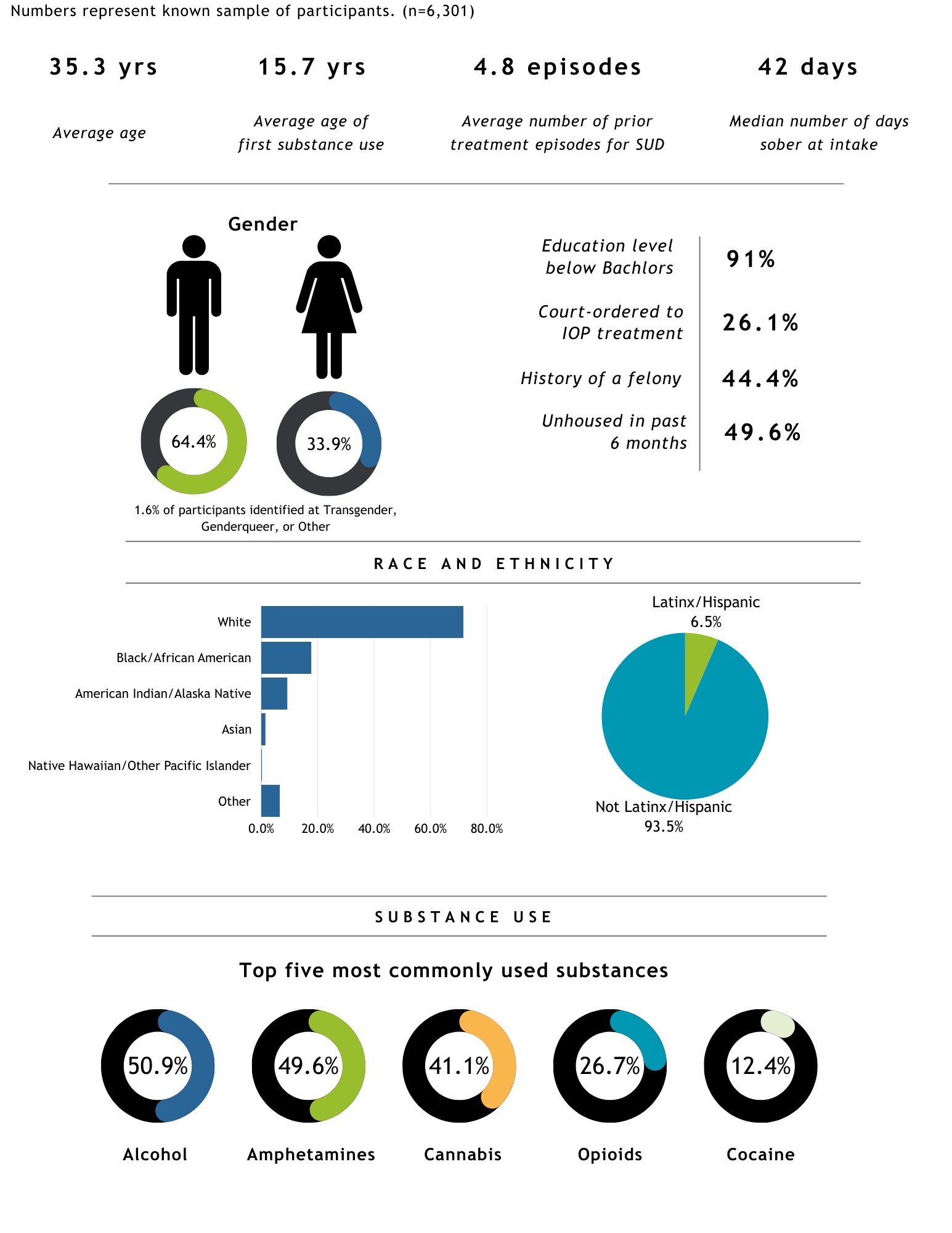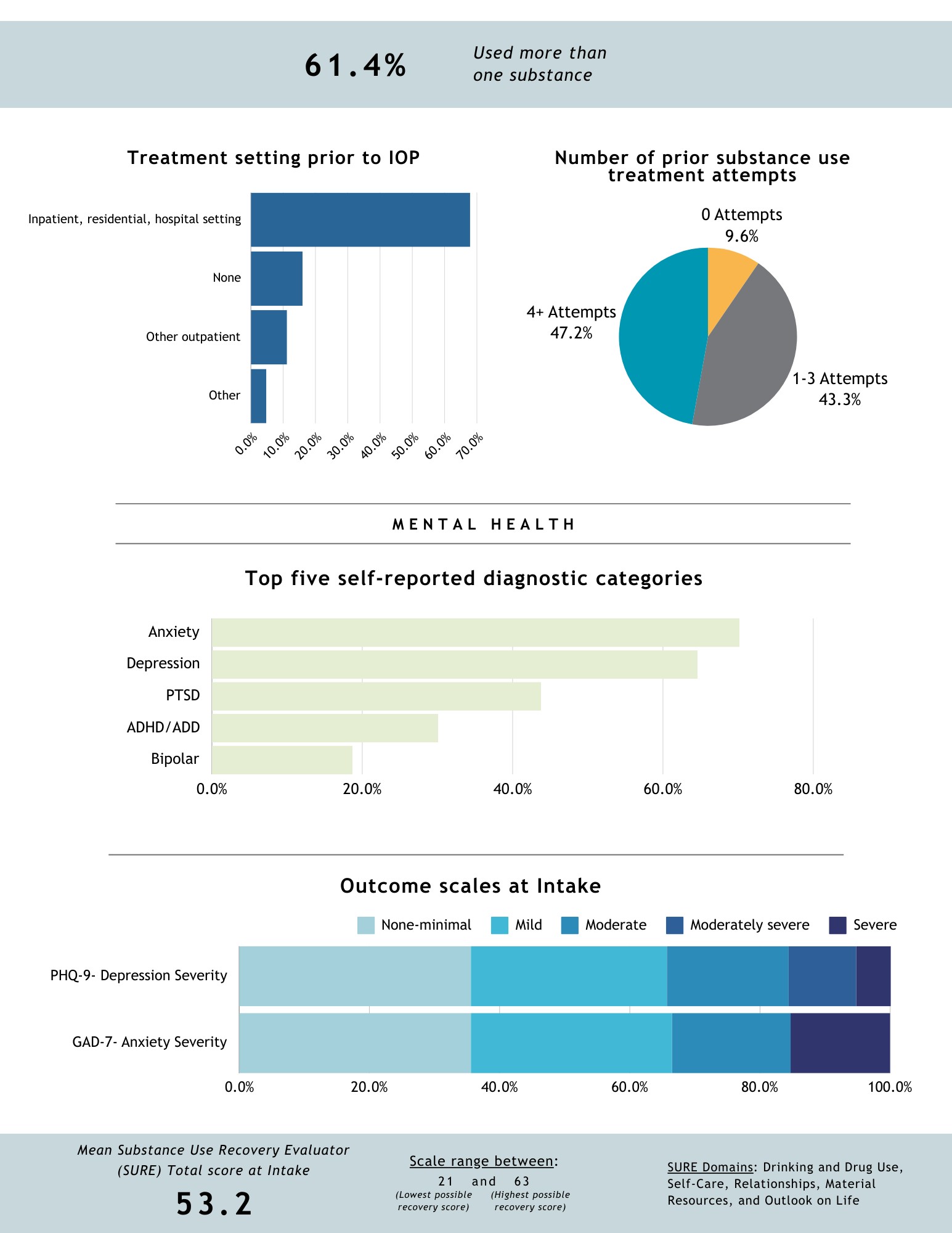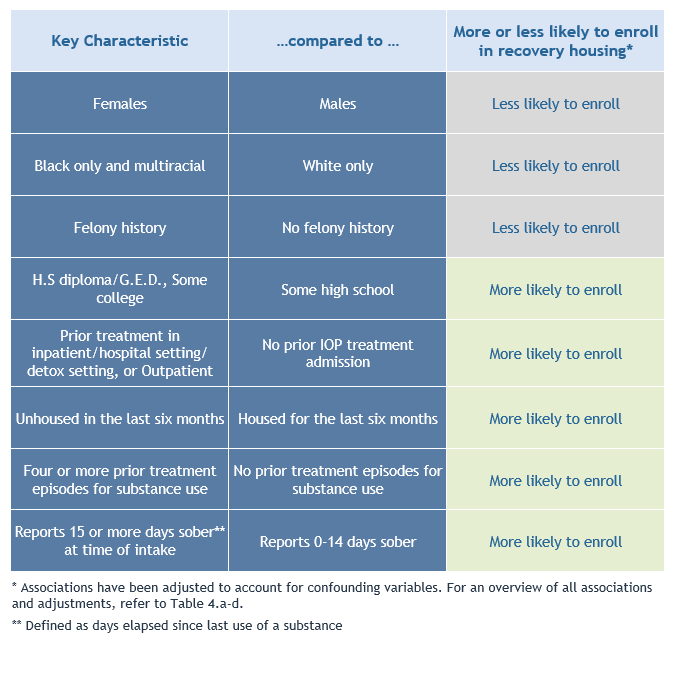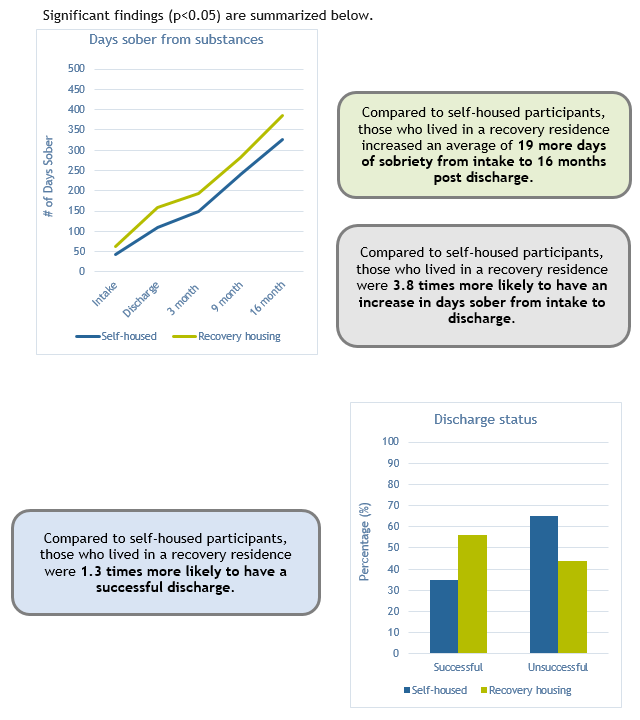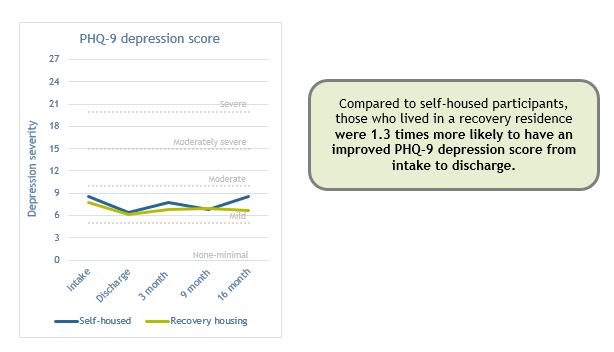Research
At the Center, we support all of our activities with sound evidence gathered through research. We collaborate with local and national experts to discover effective recovery oriented practices that can be readily applied. We seek to answer the questions that are relevant and important to every practitioner: what works best for who and why?
Current Research
The Impact of Integrated Recovery Housing on Clinical Outcomes
- Michael Van Wert, MPH, MSW, LICSW
- Emily Gus, MPH
- Jennifer Wiseman, MPS, LADC
- Julie Rohovit, Ph.D.
The Center for Practice Transformation was hired by Minnesota’s largest non-profit extended care addiction and mental healthcare treatment provider NUWAY® House, Inc. (NUWAY®) to study the effects of integrated recovery housing on clinical outcomes with the goal of providing data-driven care to people in recovery. The program evaluation, which began in 2019, is ongoing and has enrolled over 6,000 participants over the course of the project. This study has provided a wealth of information, allowing NUWAY® to augment programming to better serve its clients using data collected and analyzed by CPT, an unbiased third-party. More and more, programs are required to demonstrate effectiveness using data-driven approaches. NUWAY® is serving as a model for programs in Minnesota and nationwide by engaging in scientifically sound research on clinical outcomes.
Click here for the full report: NUWAY UofM RISE Report 2023
Click here for a poster presentation of this data at the 2024 CEHD Research Day and the 2024 NAADAC Annual Conference.
WHAT WAS THE EVALUATION DESIGN?
WHO WAS IN THE EVALUATION?
WHO LIVED IN RECOVERY HOUSING DURING TREATMENT?
WHAT WAS THE IMPACT OF RECOVERY HOUSING?
Past Research
Research Briefs
Training MN Child Welfare Professionals In Motivational Interviewing
Among child welfare professionals (CWPs), MI has been found to increase empathy (Forrester et al., 2008; Forrester et al., 2018), collaboration (Forrester et al., 2018), and evocation skills (Forrester et al., 2018), and decrease confronting behaviors (Forrester et al., 2008). Similarly, on the client side, MI has been shown to increase parents’ engagement in substance use treatment (Carroll et al., 2001) and improve retention and recidivism among caregivers in a parenting skills program (Chaffin et al., 2009).
The Center for Practice Transformation and the Minnesota Child Welfare Training Academy ran a 28-month pilot, sponsored by the MN Department of Human Services and the Family First Prevention Services Act, which aimed to train Minnesota CWPs in MI skills. The intensive training consisted of a three-component sequence: a 2-hour self-paced introduction to MI skills, four 3.5-hour instructor-led workshops for deeper learning, and four 1-hour coaching circles to practice MI skills (Fig 1). Prior to and upon completion of the training sequence, CWPs completed skills demonstrations where they recorded themselves responding to a simulated client encounter. These recordings were coded for MI skill level using the Behaviour Change Counseling Index (BECCI, Lane et al., 2005). Coders provided structured feedback to CWPs on their performance pre and post training. CWPs who scored a certain level of proficiency (a score of 2 or above on the BECCI) on the post-training skills demonstration were certified to claim
for MI services in Minnesota.
Comparing Human And Artificial Intelligence Coding Of Motivational Interviewing Skills
Although MI has the potential to be useful in a wide range of practice settings and applications (Miller, 2023), including in child welfare (Forrester et al., 2018; Chaffin et al., 2009; Forrester et al., 2008; Carroll et al., 2001), the question of how to most effectively and efficiently train and evaluate provider MI skill remains. There are many human-coded MI fidelity measures, including the Motivational Interviewing Skills Code (MISC), the Motivational Interviewing Treatment Integrity Scale (MITI), and the Behavior Change Counseling Index (BECCI) (Gill, Oster, & Lawn, 2020; Madson & Campbell, 2006). The MITI, widely regarded as a “gold standard” for assessing MI proficiency, has been shown to correlate significantly with the BECCI, a briefer and less resource-intensive alternative (Darnell et al., 2019). Moreover, in order to further reduce the cost in time and effort to human coders, artificial intelligence (AI) platforms that evaluate MI provider performance have been paired with human trainer feedback (Hershberger et al., 2024) and within asynchronous trainings (Cheffer, Barnett, & Bullara, 2025) to improve MI skill.
Client Characteristics Associated with Change in an Intensive Outpatient Program
Intensive outpatient programs (IOPs) can be an effective treatment setting for adults struggling with co-occurring mental health and substance use disorders (SUD). Pulling from a sample of 7107 adults attending an intensive outpatient program, the present research brief sought to explore what client demographic, substance use, legal, housing, and psychiatric characteristics were associated with improvement and deterioration in overall recovery, substance use, depression severity, anxiety severity, and days abstinent from a substance from IOP intake to discharge, as well as discharge status and admission length. A range of characteristics were associated with improvement and deterioration, including client self-reported diagnostic categories, age, being court ordered to treatment, a lifetime felony history, age of first substance use, treatment setting prior to IOP intake, use of certain substances in the last year, identifying with certain racial identities, living in a recovery residence, and time in IOP treatment.
Evaluating the Impact of Recovery Housing: Looking Back, Looking Forward
In October of 2024, the Center for Practice Transformation wrapped up a program evaluation that started in 2019 examining the impact of recovery housing participation on people receiving care in an IOP targeting co-occurring mental health and substance use disorders. We were hired as independent program evaluators to study a recovery housing program paired with IOP services at a large Midwestern treatment provider. The program evaluation had two aims from the beginning. First, we sought to understand the characteristics of people who chose to live in a recovery residence while receiving IOP treatment compared to those who did not live in a recovery residence. Second, we wanted to understand the impact of living in a recovery residence on recovery, depression severity, anxiety severity, days abstinent from a substance, discharge status, and length of admission. Over 7000 participants later, we are reflecting on some of our main findings, areas for continued exploration, and the partnership that was created.
Intersecting Identities and the Decision to Live in Recovery Housing
The literature suggests that recovery housing can benefit people with co-occurring mental health and substance use disorders, but that people with marginalized intersecting identities may access these services less than their dominant identity counterparts. Pulling from a sample of 7107 adults attending an intensive outpatient program (IOP), the present research brief sought to explore whether the number of marginalized identities participants carried was associated with recovery residence participation during their IOP admission.
The Substance Use Recovery Evaluator (SURE): A Closer Look Among Adults Attending Intensive Outpatient Program for Co-occurring Disorders
In a sample of adults attending an intensive outpatient program (IOP) for co-occurring mental health and substance use disorders, the SURE, a self-reported measure of recovery, had reliability than ranged from “poor” to “excellent,” and its domains were significantly negatively correlated with measures of psychopathology, and positively correlated with sobriety. Housing status was associated with total score and the material resources subscale. Some participant characteristics were also related to SURE total score.
Housing Profiles Among Adults Attending Intensive Outpatient Program for Co-occurring Disorders
About half of adults attending an intensive outpatient program (IOP) for co-occurring mental health and substance use disorders remained in the housing situation where they started at IOP intake. Of the other half who changed housing during IOP treatment, the most common shifts were moving from a recovery residence to a permanent residence, from no permanent address/unhoused to a recovery residence, and from a permanent address to a recovery residence. Those who started treatment at a permanent address and moved to a recovery residence by discharge were more likely than those who remained in a recovery residence throughout treatment to report improvement in depression, anxiety, and recovery scores. Moving away from a recovery residence during treatment was associated with a decreased likelihood of improved outcomes.
Participation in Recovery Housing and Outcomes Among Adults with a Felony History
Adults with a felony history attending an intensive outpatient program (IOP) for co-occurring mental health and substance use disorders were more likely to be male, older, non-white, less educated, court-ordered to treatment, use amphetamines n the last year, report a diagnosis of PTSD or ADD/ADHD, have more previous treatment attempts for a substance use disorder, and first use a substance at a younger age. Those with a felony history were less likely than those without to live in recovery housing during treatment, but those who did were more likely to discharge successfully from the IOP and to have more sober days upon discharge. The following .pdf includes supplemental tables.
Disparities between Black and White Client Outcomes in Outpatient Treatment for Substance Use Disorder
The Center partnered with NUWAY® to investigate differences between Black and White clients at the time of their admission to services and at discharge. Results indicate that differences exist when clients are admitted to care and these differences are reduced at the time of discharge, showing that treatment services may play a positive role in reducing racial disparities.
Disparities between Indigenous American and White Client Outcomes in Outpatient Treatment for Substance Use Disorder
The Center partnered with NUWAY® to investigate differences between Indigenous American and White clients at the time of their admission to services and at discharge. Results indicate that the differences present when clients are admitted to treatment are not present at the time of discharge, indicating that treatment services are associated with reduction in disparities among Indigenous Americans with substance use disorders.
Predictors of Successful Discharge from Intensive Outpatient Treatment for Substance Use Disorders
The Center partnered with NUWAY® to investigate the association between participant characteristics and metrics of recovery at admission with successful completion of their treatment program. Results indicate that both demographic characteristics and recovery metrics are significant predictors of successful treatment completion.
Predictors of Client Dropout from Intensive Outpatient Substance Use Disorder Treatment
The Center partnered with NUWAY® to investigate the association between participant characteristics and metrics of recovery at admission and early dropouts from treatment. Results indicate that recovery metrics are better predictors of early dropout from SUD treatment.
Recovery Residence Populations: Differences in Characteristics of R.I.S.E. Participants and Self-Housed NUWAY® Clients
The Center and NUWAY® partnered to study the demographic differences between individuals who chose to participate in recovery housing and those who did not while receiving intensive outpatient care at NUWAY®. Results show women and people who are court ordered to treatment are choosing recovery housing at lower rates.
Recovery Residences and Improved Outcomes: The Association Between R.I.S.E. and Clinical Outcomes
The Center partnered with NUWAY® to investigate the association between living in recovery residences while attending intensive outpatient treatment and recovery outcomes. Results indicate that integrating recovery residences and intensive outpatient programming is associated with improved recovery outcomes.
The Effectiveness of Telehealth for Substance Use Disorder Treatment
The Center and NUWAY® partnered to investigate telehealth as a service delivery model in substance use disorder treatment. Results indicate a blend of in-person and telehealth services may deliver a flexible and ultimately effective experience for people receiving care.
Treatment of Co-occurring Mental Health and Substance Use Disorders: Preparedness of Social Workers and Alcohol and Drug Counselors in Minnesota
Of the 9.2 million Americans with co-occurring mental health and substance use disorders (CODs), only 44.4% received treatment for either mental illness or substance use disorder alone, while an even smaller minority (7.7%) received treatment for both (SAMHSA, 2012).
Integration of Mental Health and Primary Care: Barriers, Strategies, and Recommendations
Individuals with serious mental illness have a much shorter lifespan than the general population, with increased incidence of physical illness such as hypertension, diabetes, and respiratory disease (De Hert et al., 2011). To address the life expectancy gap between those with serious mental illness and the general population in Minnesota, the 10 x 10 initiative was started in 2008. The goal of this initiative is to increase the lifespan of individuals with serious mental illness by 10 years within 10 years.
Piloting Integrated Illness Management and Recovery with Assertive Community Treatment Teams: Targeting Physical Health in Persons with Serious Mental Illness
The Minnesota 10 by 10 initiative, led by the Minnesota Department of Human Services, has set a goal to increase the life expectancy of individuals with SMI by 10 years, in 10 years from its commencement in 2011 (Minnesota Department of Human Services, 2011). As part of the Minnesota 10 by 10 initiative, resources were developed to create opportunities for increasing discussion surrounding physical health screenings between health care providers, practitioners, clients, and their family members. The Center trained 10 ACT teams across Minnesota in the I-IMR model to examine the feasibility of an individualized intervention to address both mental and physical health needs. This Research Brief highlights the outcomes of the intervention.
Trainings Tailored to Your Team’s Needs
Talk with us about how we can build an evidence-based practice training plan for your team.

